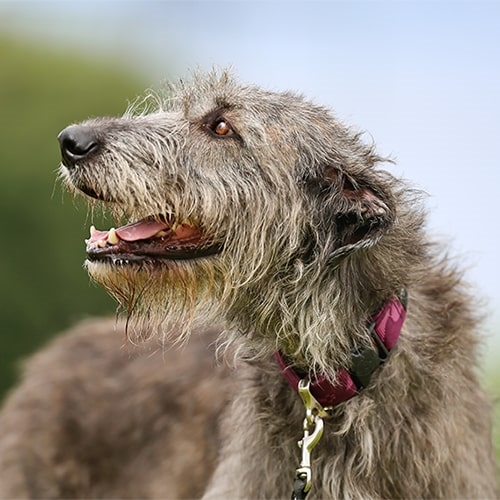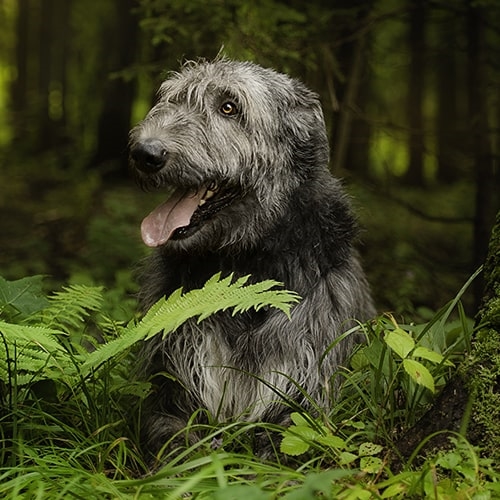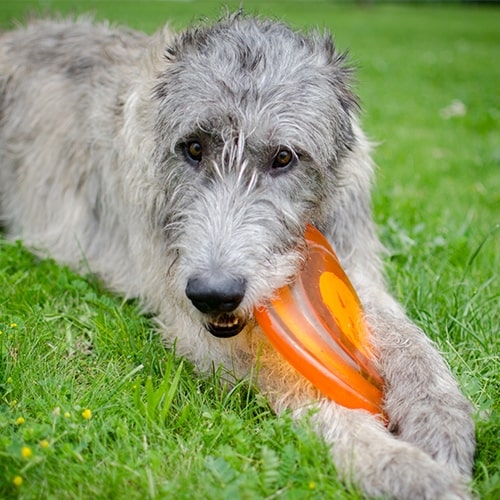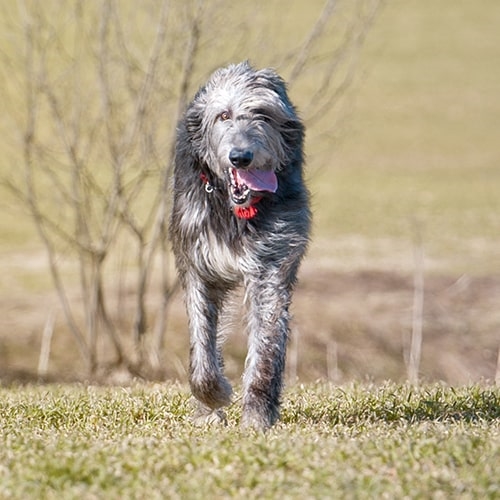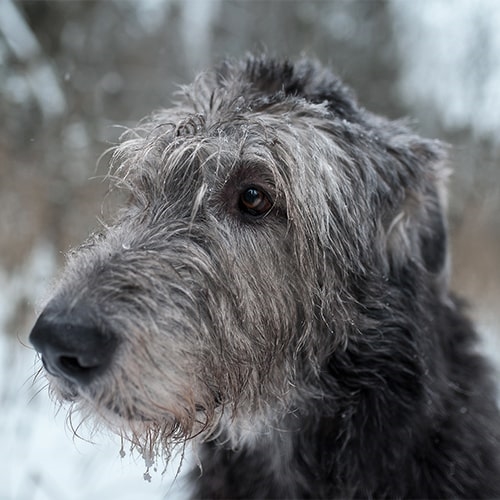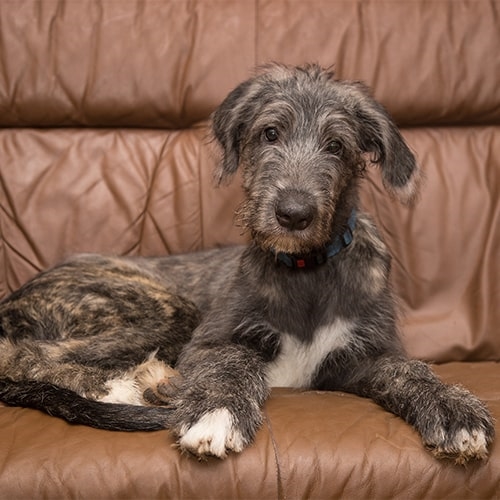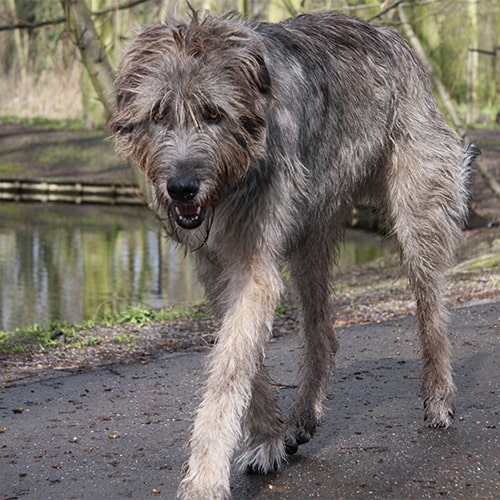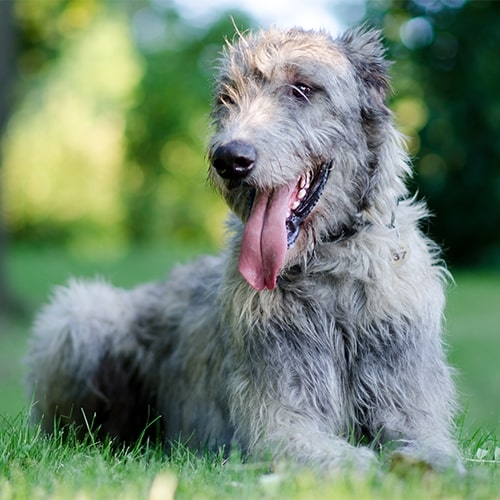| Size | Large |
|---|---|
| Average height | 71-79 cm |
| Average weight | 40-55 kg |
| Average lifespan | Under 10 years |
| Minimum exercise (per day) | 2 hours |
| Coat length | Medium |
| Minimum cost (per month) | £105 |
Irish Wolfhounds are a large and powerful breed but known for being big softies at heart. With the right training and socialisation they can be very friendly with people and other dogs.
Although they were originally bred for protecting livestock from wolves in Ireland, Irish Wolfhounds are now mostly family pets due to their calm and relaxed nature. They do well with experienced owners with time for them. Being such a large breed, they also suit larger homes with plenty of space. You may even need to invest in a bigger car to be able to take your dog out exploring or for visits to the vets!
Common health problems in Irish Wolfhounds
Irish Wolfhounds are very gentle despite their colossal size and loved for their ‘shaggy’ appearance and ability to get along with anyone and everyone. Unfortunately, like so many other pure bred dogs, they are at risk of certain problems and conditions relating to their breed.
If you are thinking of buying an Irish Wolfhound puppy, make sure the parents of your puppy have had the relevant health screening to reduce the chances of your puppy being affected by certain conditions. We’d recommend looking for a Kennel Club Assured Breeder as they meet extra requirements which will benefit your puppy’s health.
Some of the conditions Irish Wolfhounds may develop include:
- Gastric Dilatation Volvulus (GDV) – often known as ‘bloat’, this is where the stomach twists. It is an emergency and requires urgent veterinary attention.
- Certain cancers.
- Cardiomyopathy – a type of heart disease which means their heart is bigger than it should be and doesn’t function properly.
- Generalised retinal progressive atrophy – loss of sight, which gets worse over several months or years.
- Portosystemic shunt (liver shunt) – a birth defect where blood certain organs bypasses the liver and misses vital filtration of toxins meaning a build-up in the bloodstream. There is testing available for this.
- Heart disease - all dogs used for breeding take part annually in a heart testing scheme approved by the Irish Wolfhound Club, the minimum requirement being examinations by stethoscope, ECG and ultrasound scan.
If you want to minimise the risk of your dog getting problems due to exaggerated features, you can read our advice on choosing a pedigree dog.
Caring for your Irish Wolfhound
Irish Wolfhounds are considered to be gentle giants and can be great pets in the right household, but due to their large size and strength they may not be suited to everyone. Although they seem fairly chilled out, they need plenty of exercise and space to stretch out. Owners will need a large, secure garden for their Irish Wolfhound.
Irish Wolfhounds thrive off company and like most dogs will get upset if they are left alone. You might find they become destructive if they’re on their own to relieve stress, which could mean a big mess for a big dog!
Irish Wolfhounds and barking
Like most dogs, Irish Wolfhounds are likely to make noise and it all depends on the training, socialisation and personality of your dog as to how much they bark. In general, Irish Wolfhounds are not known for being big barkers. They do have a fairly loud bark though and will certainly use it to let you know if they are unhappy. If you’re having problems with excessive noise or barking, we recommend seeking the advice of an accredited behaviourist.
Training and socialisation
Irish Wolfhounds do best with owners who are familiar with the breed. Although they are an intelligent breed, Irish Wolfhounds need to be handled gently and positive, reward-based training needs to start from a young age. They really don’t respond well to anything negative so be consistent with reward-based methods. You’ll need to be very patient when training your Irish Wolfhound due to their sensitive nature. We would recommend contacting an accredited trainer for guidance.
Irish Wolfhounds form really strong ties with their families and are a very social breed. This means they’ll love spending time with people and other dogs as long as they have been socialised from a young age. You’ll also need to make sure you socialise them with different experiences so they grow to be a well-rounded and confident dog.
Irish Wolfhounds form strong bonds with their owners and might not cope being left alone even for short periods of time. You may need to train your dog that it’s OK to be alone but this should never be for more than four hours. Irish Wolfhounds tend to suffer with separation anxiety and might be destructive around the home if left alone.
Exercise
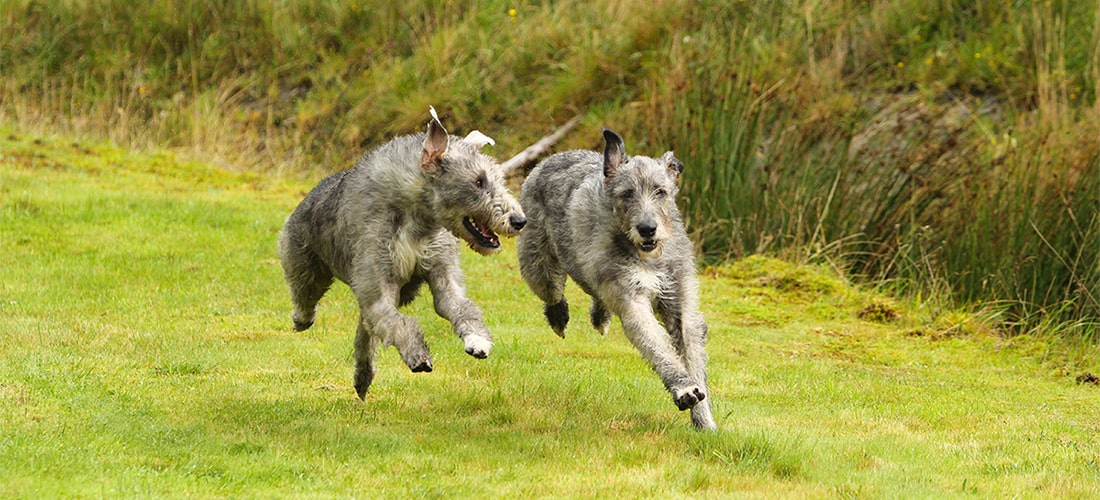
Although they have laid-back personalities and never seem in a hurry to do anything, Irish Wolfhounds still need a lot of exercise so don’t be fooled by any apparent laziness! They’ll need space to stretch and chill out inside, with room outside to run around and play. You might want to try to keep playtime to outdoors as an excited Wolfhound might end up accidentally knocking your valuables.
Your Irish Wolfhound will need a minimum of two hours of exercise every day to keep them fit and healthy. It’s better to spread this across the day rather than doing two hours in one go. We’d recommend splitting this into walks and off-lead exercise in a safe area. Make sure that at least one of your walks gives your dog chance to have a good sniff and nose around. On top of this, your Wolfhound will need plenty of playtime and training sessions along with free time in the garden for a bit of variety. Because of their large size and quick growth, you’ll need to take exercise easy while they are a puppy – you can read more on our website.
Grooming
You can expect your Irish Wolfhound to shed throughout the year but compared to longer-haired dogs this is fairly minimal. Brushing them around twice a week should be more than enough to keep their coat in good condition and stay on top of the dead hairs. You might find they shed more in spring and autumn but this is perfectly normal and a little more brushing should help.
Irish Wolfhounds have quite wiry fur giving them their shaggy appearance. Your dog shouldn’t need bathing unless they roll in something smelly, but if you ever need to you might want to take them to a professional groomer. Their large size might make it a bit tricky at home!
Irish Wolfhounds and children
Irish Wolfhounds can be great with children if they have been properly socialised from a young age. That said, we wouldn’t recommend having an Irish Wolfhound if you have smaller children simply because of their size and strong build – they often don’t know their own strength and could accidentally knock smaller children over. They are the ideal pet for families who have experience with the breed.
Always supervise your Irish Wolfhound with children and vulnerable adults to avoid any accidents. Although they are known for being calm and have a good reputation with children of all ages, it’s best to have someone around who is experienced and can recognise if your Wolfhound has had enough.
Irish Wolfhounds and other pets
Irish Wolfhounds are known for their highly social personalities and given the right socialisation from a young age shouldn’t be aggressive towards other dogs. They’re likely to welcome any chance to say hello to other dogs they meet.
As Irish Wolfhounds do have a high prey drive, we wouldn’t recommend keeping them with smaller pets. They might get along with a cat if introduced from a young age but any introductions should be done very slowly and carefully and you should always supervise their time together. Make sure you keep a tight grip on their lead out and about in case they see something they’d like to chase!
Food
Your Irish Wolfhound’s diet will vary depending on their age. You’ll need to feed them a complete, balanced dog food to keep them slim and healthy.
Your vet will be able to tell you how much your Irish Wolfhound should be eating. Keep in mind that due to their size, your Irish Wolfhound may eat more than you expect and food bills can quickly rise. You should feed them a good quality, commercially available, complete dog food. We usually recommend splitting their daily allowance into two meals. If you give your dog the occasional treat or use treats for training, remember to take this into account and reduce their daily allowance. Treats shouldn’t make up more than 10% of their daily calorie intake as this can unbalance their diet.
You should try to feed your dog at the same time every day to get them into a routine. Remember to leave at a gap after eating and before exercising as this can help reduce the chances of GDV (bloat).
The cost of owning an Irish Wolfhound
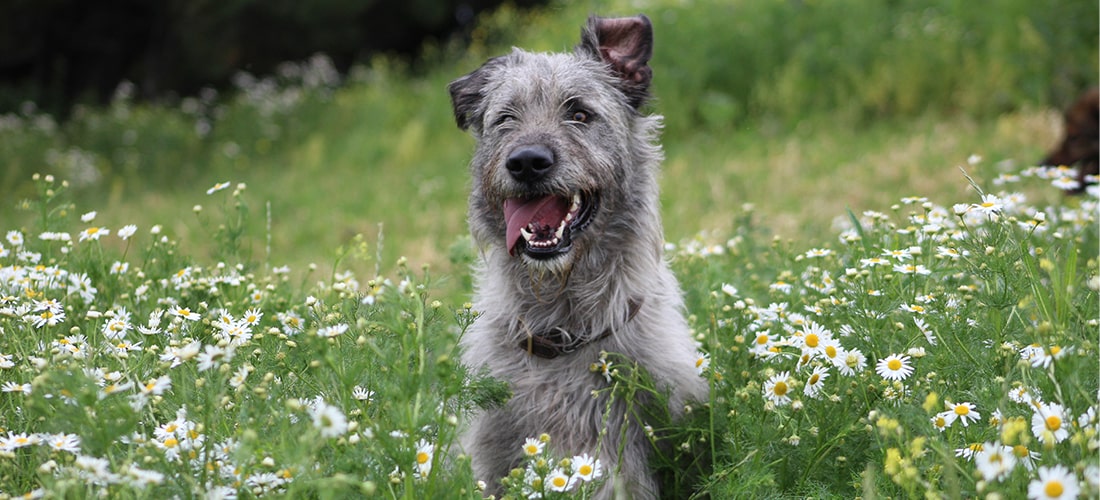
You can expect your Irish Wolfhound to cost you a minimum of £105 per month after purchase and set-up costs and over £17,000 across their lifetime.
Costs you’ll need to think about include:
Purchase costs
Adopting an adult Irish Wolfhound from a rescue centre may be a more cost-effective option, with the added advantage of giving a home to a pet without one – check if the rehoming centre you’re looking at asks for a donation for rehoming.
If instead you’re buying an Irish Wolfhound puppy from a breeder, you’ll need to factor in this cost. Beware unusually cheap puppies as they could come from a puppy farm. If you’d like to buy a pedigree puppy, we recommend looking for a Kennel Club Assured breeder. These breeders must do extra health tests and meet high standards.
Set-up costs
- Puppy vaccines – if you rescue a dog, reputable centres will often vaccinate them for you. Remember that ongoing booster vaccinations will be needed to continue their immunity.
- Neutering – you should usually arrange for your dog to be neutered at around 6-12 months old, although Irish Wolfhounds mature much slower than other breeds so it’s best to speak to your vet to find out exactly when to neuter your dog. Check prices at your local practice as these will depend on your vet and where you live. Some rescue centres will neuter any dogs they rehome, saving you this cost.
- Equipment – including a collar and tags, lead, harness, dog beds, dog bowls, pet-safe toothpaste and toothbrushes, grooming brushes and toys. Keep in mind that all these will need to be replaced with wear or damage or if your dog outgrows or damages them!
Ongoing costs
- Food.
- Preventive healthcare – budget for routine vet visits to help stop your dog getting ill and catch any problems early. They need annual check-ups, vaccinations and regular flea and worming treatments. Check if your vet offers a health care plan as this can help spread the cost throughout the year.
- Vet bills* or pet insurance – if you don’t have pet insurance and your dog needs veterinary treatment for an injury or illness, costs can rapidly mount up. Check what’s covered and what isn’t when comparing policies.
- Accessories – including lots of poo bags, replacing worn toys and grooming accessories, buying doggy toothpaste and any other extras they might need.
Other costs
- Training – basic training is very important and dogs can benefit from formal classes. Some dogs may have, or develop, behavioural problems which might need professional management.
- Boarding – you may also need to budget for boarding or dog sitting costs if you are planning to go away from home on holiday.
- Dog walkers/day-care – you might consider a professional dog walker to keep your dog happy and healthy if you’re unable to get out with your dog enough yourself, or to look after them during the day if you need to be out for more than four hours.
* It’s always better to plan ahead and budget or get pet insurance in case your pet gets injured or unwell. If you are having difficulty with veterinary costs, you can check if you are eligible for treatment at PDSA here.
If you’re considering pet insurance, our PDSA Pet Insurance could be a great option for you and it’s quick and easy to get a quote online.
Fun facts
- Irish Wolfhounds are super tall – likely bred into them because they were used to hunt some pretty big animals (wolves, deer and even bears!).
- Despite their huge exterior, Irish Wolfhounds are big softies at heart and make terrible guard dogs as they love people too much.
- They can be very quick (when they can be bothered!) and their speed was good for their days hunting.
- In the past, they were used as war dogs to drag soldiers off their horses. A far cry from the sweet pets we know today!
Getting an Irish Wolfhound
Do plenty of research before you get an Irish Wolfhound. Despite appearing lazy around the home, they love to run and play outside and still need a lot of exercise to stay happy and healthy. Although they take a lot of time and patience, Irish Wolfhounds make loving and loyal companions and fit in really well with family life.
Rehoming centres
There are plenty of rescue centres across the country where you may find an Irish Wolfhound. Breed-specific rescues that specialise in Irish Wolfhounds are also out there. You’ll need to ask any rescue centre about the dog’s history to make sure they will be comfortable in your home. Good rescue centres should let you know of any health and behaviour problems.
Breeders
If you buy an Irish Wolfhound puppy from a breeder, make sure your puppy will be well socialised and have all necessary screening tests, health checks and vaccinations. It’s really important that Irish Wolfhound puppies from a breeder get the right early socialisation so always ask the breeder about how they go about this. We recommend looking for a Kennel Club Assured breeder as they meet higher standards. We’ve put together some advice to help you find a good breeder.

